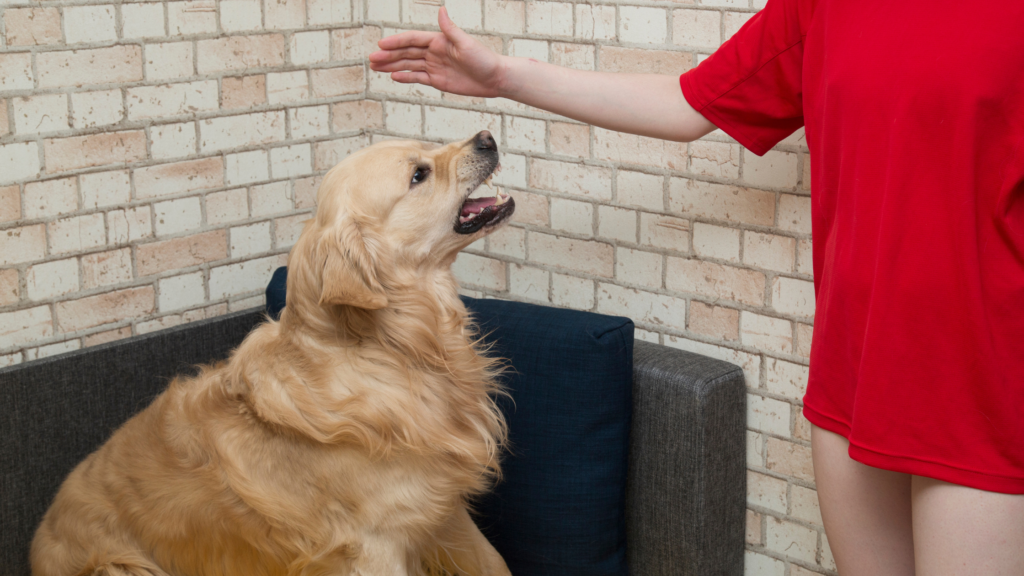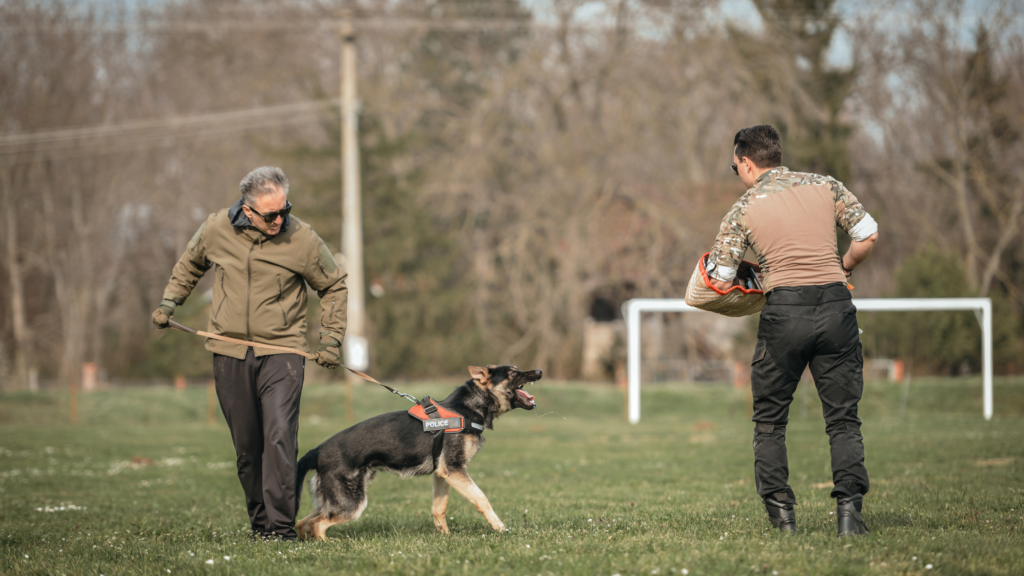The Power of Aggressive Dog Board and Train Programs – In dog training, aggressive behavior can be a significant challenge for dog owners and their furry companions.
However, there is hope! Board and train programs have emerged as a highly effective solution for addressing and rehabilitating aggressive dogs.
In this article, we will delve into the concept of aggressive dog board and train programs, exploring their benefits, methodologies, and much more.
Whether you’re a concerned dog owner or a professional in the field, this content will provide valuable insights into how aggressive dogs can find their path to a happier, more balanced life.
Understanding Aggression in Dogs

Aggression in dogs can be a complex behavior that stems from various factors.
Dog owners and enthusiasts need to thoroughly understand aggression to ensure the well-being of their pets and those around them.
Differentiating between Types of Aggression
Regarding aggression, dogs can exhibit different types with underlying causes.
Recognizing and differentiating between these types is crucial to address the issue effectively.
Some common types of aggression in dogs include:
- Fear Aggression: Dogs may display aggression when they feel threatened or afraid. This type of aggression often stems from past traumatic experiences or lack of socialization.
- Territorial Aggression: Dogs may become protective of their territory, showing aggression towards unfamiliar people or animals that enter their perceived space.
- Resource Guarding Aggression: Some dogs may display aggression when they need to protect their resources, such as food, toys, or sleeping areas.
- Dog-to-Dog Aggression: This type of aggression occurs when dogs show hostility towards other dogs. It can be rooted in competition, fear, or a lack of social skills.
Identifying Signs and Triggers of Aggression
To effectively manage and address aggression in dogs, it’s crucial to identify the signs and triggers that lead to aggressive behavior.
These signs may include:
- Growling or snarling
- Barking excessively
- Lunging or snapping
- Raised fur and rigid body posture
- A stiff tail or wagging tail held high.
Triggers for aggression can vary among dogs, but common ones include:
- Fear or anxiety-inducing situations
- Threats to their territory or resources
- Lack of socialization or improper training
- Pain or discomfort
- Previous traumatic experiences
By recognizing these signs and triggers, dog owners can take proactive steps to manage aggression and create a safe environment for their pets and those around them.
Seeking professional help from a qualified dog behaviorist or trainer is often recommended to address aggression issues effectively and safely.
Remember, understanding and addressing aggression in dogs requires patience, consistency, and a commitment to providing appropriate training and socialization.
Aggressive behavior can be managed with the right approach, allowing dogs to live happy and balanced lives.
The Aggressive Dog Board and Train Approach

When addressing the specific needs of aggressive dogs, the board-and-train approach has gained popularity as an effective training method.
This approach involves sending the dog to a specialized facility or trainer for an intensive training program, where they receive dedicated attention and guidance.
What is Board and Train?
Board and train, also known as “doggie boot camp,” is a comprehensive training program that provides a structured environment for dogs to learn and modify their behavior.
During the program, the dog resides at the training facility for a set duration, typically ranging from a few weeks to a few months, depending on the severity of the aggression.
How it Differs from Traditional Training Methods
Board and train differs from traditional training methods in several ways.
While traditional training often involves regular classes or sessions with the owner and dog, board and train offers a more immersive and intensive approach.
Trainers work closely with the dog daily, providing consistent training, socialization, and behavior modification.
In a board and train program, trainers can observe the dog’s behavior in various situations and environments, allowing for a more thorough understanding of the underlying causes of aggression.
This comprehensive approach enables them to address the dog’s specific needs and implement tailored training techniques accordingly.
Why It’s Effective for Aggressive Dogs
Board and train programs are particularly effective for aggressive dogs due to the structured and controlled environment they provide.
Aggressive behaviors can be deeply ingrained and challenging to address, requiring dedicated time, expertise, and consistency.
By immersing the dog in a focused training program, trainers can work closely with the dog to modify their behavior and teach them alternative, more appropriate responses.
Furthermore, board and train programs often incorporate controlled socialization with other dogs and humans, gradually exposing the dog to different stimuli and helping them learn proper social skills.
This exposure, combined with consistent training, helps to reshape the dog’s behavior and reduce aggressive tendencies over time.
It’s important to note that board and train is not a quick fix or a substitute for ongoing owner involvement.
After completing the program, owners must continue reinforcing the training techniques and strategies learned during the board and train program to maintain the dog’s progress.
Overall, the board and train approach provides a focused, intensive, and controlled training environment that can effectively address the specific needs of aggressive dogs.
Combined with ongoing owner involvement and reinforcement, it can help these dogs learn new behaviors, reduce aggression, and improve their overall well-being.
Choosing the Right Board and Train Program
When selecting a board and train program for your aggressive dog, it’s important to make an informed decision that suits your dog’s needs and expectations.
Here are some key factors to consider when choosing the right program:
Program Structure and Approach
Different board and train programs may have varying structures and training methodologies.
It’s important to understand the specific approach used by each program and ensure that it aligns with your goals and training philosophy.
Some programs focus on positive reinforcement techniques, while others employ more balanced training methods.
Consider what training approach you feel comfortable with and what you believe will be most effective for your dog.
Qualifications and Expertise of Trainers
The qualifications and expertise of the trainers should be a crucial consideration.
Look for trainers with experience working with aggressive dogs and a solid understanding of behavior modification techniques.
Ask about their certifications, education, and any specialized training they have received.
A reputable program will have knowledgeable and skilled trainers who can address the unique needs of your aggressive dog.
Facility and Environment
Take the time to visit the facility where the board and train program is conducted.
Assess the cleanliness, safety, and overall environment of the facility.
A well-maintained facility with adequate space and proper equipment can provide a positive training experience for your dog.
Success Stories and Testimonials
Look for reviews, testimonials, or success stories from previous clients who have enrolled their aggressive dogs in the board and train program.
Positive feedback and success stories can provide insights into the program’s effectiveness and the trainers’ abilities to handle aggressive behavior.
Don’t hesitate to contact past clients or ask for references to understand their experiences better.
Follow-up Support and Continued Training
Inquire about the post-program support provided by the trainers.
A reputable board and train program will offer guidance and resources for owners to continue reinforcing the training once the dog returns home.
Ongoing support is crucial for maintaining the progress achieved during the program and ensuring a smooth transition back into the home environment.
Remember, each dog is unique, and what works for one dog may not work for another.
Take the time to research and evaluate different board and train programs, ask questions, and consider your dog’s specific needs before making a decision.
By selecting a program with qualified trainers, a tailored approach, and positive reviews, you increase the likelihood of finding a board and train program that will help address your dog’s aggression and set them on the path to behavioral improvement.
Also Read: How to Train a Carolina Dog and Unleash Their Full Potential
Aggressive Dog Board and Train – The Training Process
When enrolling your aggressive dog in a board and train program, you can expect a structured training process designed to address their specific behavioral issues.
Here are the key components of the training process:
Assessment and Evaluation
The first step is to assess and evaluate your dog’s aggressive behavior thoroughly.
This helps the trainers understand the root causes of the aggression, identify triggers, and assess the severity of the issue.
Through this evaluation, they can develop a customized training plan tailored to your dog’s needs.
Tailored Training Techniques
Each aggressive dog requires a unique approach to training.
Trainers will employ specialized techniques that are specifically designed to address aggression.
These techniques may include desensitization and counterconditioning, impulse control exercises, and obedience training.
The trainers will adapt the training methods to suit your dog’s temperament, learning style, and specific behavioral challenges.
Positive Reinforcement
Positive reinforcement is a key aspect of training aggressive dogs.
Trainers will utilize rewards such as treats, praise, and play to reinforce desired behaviors and create positive associations.
This approach focuses on rewarding good behavior rather than punishing or correcting negative behavior.
Using positive reinforcement, trainers can encourage your dog to respond appropriately and reduce aggressive tendencies.
Behavior Modification Strategies
Behavior modification strategies aim to change your dog’s emotional response to triggers that elicit aggression.
Trainers will gradually expose your dog to controlled situations where they encounter these triggers, helping them learn new, more positive behaviors.
This process may involve gradual exposure, desensitization, and counterconditioning to replace negative reactions with calm and appropriate responses.
Throughout the training process, trainers will closely monitor your dog’s progress and make necessary adjustments to the training plan.
They will provide consistent guidance and support to ensure your dog makes positive progress in behavior improvement.
It’s important to note that training aggressive dogs requires patience, consistency, and commitment from both the trainers and the dog owners.
The training process may take several weeks or even months, depending on the severity of the aggression and the individual dog’s progress.
However, with a tailored approach, positive reinforcement, and behavior modification strategies, the goal is to help your dog overcome aggression and develop more desirable behaviors.
By enrolling your aggressive dog in a board and train program that focuses on assessment, tailored techniques, positive reinforcement, and behavior modification, you are allowing them to learn new behaviors, gain self-control, and improve their overall quality of life.
Aggressive Dog Board and Train – Aftercare and Continued Support
Once your aggressive dog completes the board and train program and returns home, it’s crucial to ensure a smooth transition and maintain its progress in the long term.
Here are some key aspects of aftercare and continued support:
Transitioning Back Home
Returning home after the board and train program can be an exciting but potentially challenging time.
Trainers will guide how to create a structured and supportive environment for your dog.
They may recommend gradual reintroduction to familiar surroundings, family members, and other pets to help your dog adjust comfortably.
Following the trainers’ instructions during this transition period is essential to reinforce the newly learned behaviors.
Maintenance Exercises
To maintain the progress achieved during the board and train program, trainers will provide you with specific exercises and techniques to practice with your dog at home.
These exercises are designed to reinforce the training, strengthen the bond between you and your dog, and help them continue to exhibit desired behaviors.
Regularly practicing these exercises will ensure that your dog retains their training and continues to improve over time.
Importance of Ongoing Training and Reinforcement
Continued training and reinforcement are vital for the long-term success of your dog’s behavior improvement.
This may involve attending follow-up sessions with the trainers or enrolling in additional training classes.
Ongoing training helps solidify your dog’s training foundation, address any new challenges, and reinforce positive behaviors.
It also allows you to strengthen the bond with your dog further and enhance their overall obedience and social skills.
Professional Support
Even after the board and train program, it’s beneficial to have access to professional support and guidance.
Trainers can offer advice, answer questions, and provide assistance when needed.
They understand your dog’s unique needs and can offer valuable insights into managing their behavior and ensuring long-term success.
Remember, each dog is unique, and the duration of aftercare and continued support may vary.
It’s important to follow the trainers’ recommendations and communicate openly with them to address any concerns or challenges.
By prioritizing aftercare and continued support, you can maximize the benefits of the board and train program and help your dog maintain their improved behavior.
Consistency, ongoing training, and reinforcement significantly ensure your dog’s long-term success and create a harmonious and balanced relationship between you and your furry friend.
Also Read: Can Bird Seed Kill a Dog? Exploring the Risks and Safety Measures
Conclusion
Aggressive dog board and train programs offer hope for dog owners facing aggression challenges.
With the right program and professional guidance, aggressive dogs can transform remarkably, finding a new lease on a life filled with love, trust, and harmony.
By exploring the topics covered in this article, we aim to empower dog owners and professionals alike to make informed decisions and provide the best possible care for their furry friends.
Let’s pave the way for a brighter future for aggressive dogs through effective board and train programs.
